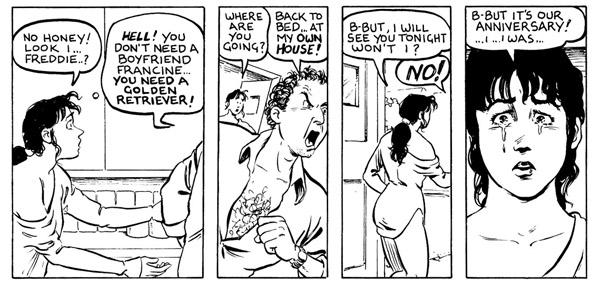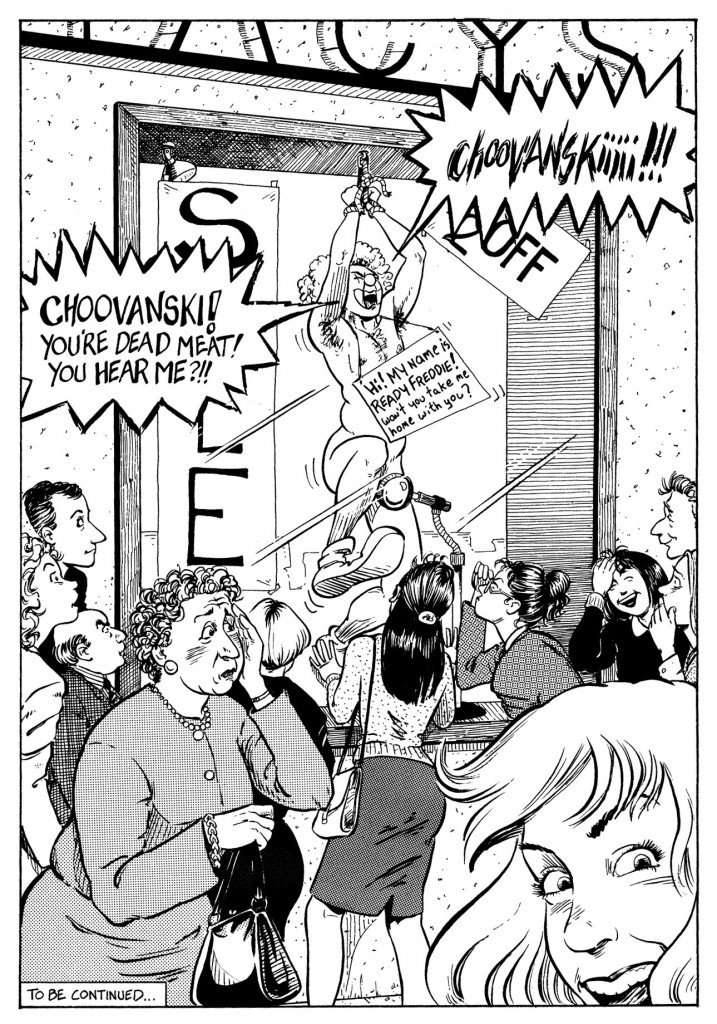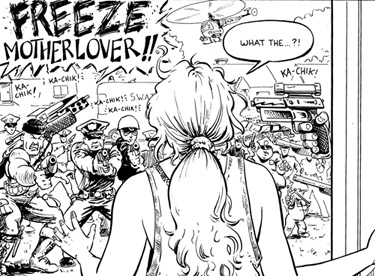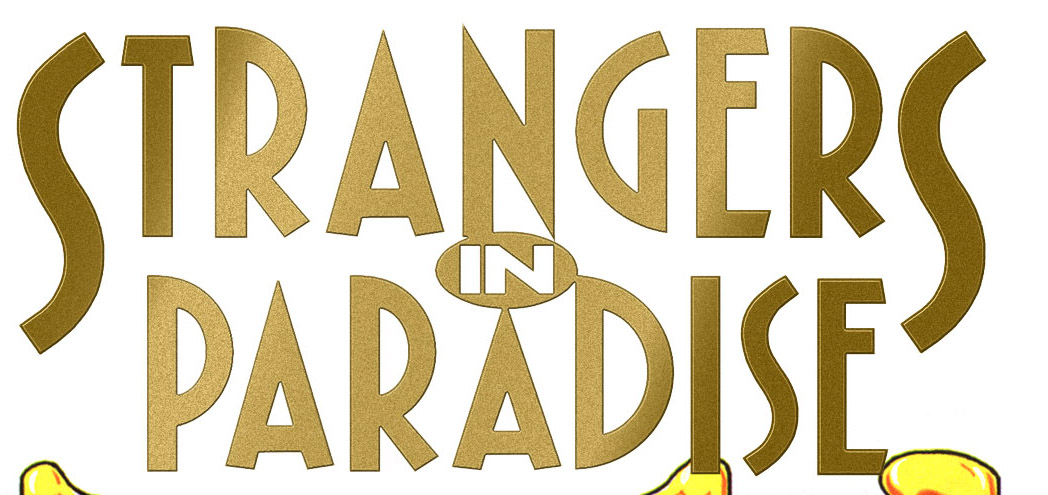There are a lot of details in Strangers in Paradise that add up to make it an excellent book. It’s written and drawn by Terry Moore; since it’s all done by the same person, you know that everything you’re seeing is the absolute intent of the creator, rather than an interpretation on someone’s part that might have given you the wrong idea. It’s in black and white, which both adds charm and lets you focus on the details that Moore has included. It’s not a book about superheroes, and while I do love reading about superheroes, it’s great to see something that’s about regular people (even if the situations aren’t the kinds of things that happen to everyone every day, they’re all things that you can see happening in the real world). It also has a great cast of characters, all of whom are presented in ways that surprise and delight me as a reader.
The thing that captivated me in Strangers in Paradise was Moore’s representation of gender throughout the story. Our four main characters in the first volume are Katchoo, Francine, David, and Freddie – two women and two men. The really interesting thing about Moore’s characterization is that each person portrays a specific kind of stereotype of their gender… and in doing so, manages to at least partially overcome that stereotype.
Francine is the feminine girly-girl. She worries about finding the right guy, and what she’ll have to do to keep him around. After the establishing scene (Francine and Katchoo in high school, which is mostly shown to tell us how long they’ve been friends, and how close they are), the first thing we get is Francine and her boyfriend Freddie, in bed at night. Freddie is begging for sex, but Francine keeps putting him off; in the morning-after scene, we find out that Francine has asked Freddie to wait for some unspecified time before they have sex.
Freddie is our sex-crazed jerk of a male character. He pressures Francine for sex and ends up cheating on her and breaking up with her because she didn’t want to jump into bed with him. Even when Francine agrees to sleep with him, he leaves her because she “held out on him” for so long.

Francine’s best friend and roommate is Katina Choovanski, mostly referred to as Katchoo. She’s a no-nonsense chain-smoking lesbian artist, and she’s in love with Francine (who seems mostly afraid to return Katchoo’s feelings because of her longing to be a wife and mother). Katchoo spends most of the first three issues either raging at men in general or being Francine’s knight in shining armor.
Our fourth main character is David Qin. He’s a fairly shy, incredibly sensitive guy; he meets Katchoo at an art exhibit, and manages to charm her into getting a cup of coffee with him. He quickly falls for Katchoo, even though she bluntly tells him first that she’s not interested in him, and then that she’s not interested in men at large. He sticks around, though, willing to at least be a friend if not more.

After the Francine-and-Katchoo flashback, we get the scene with Freddie pressuring Francine for sex, and then walking out on her (on the morning of their anniversary, no less) because he’s sick of waiting for Francine to sleep with him.

Katchoo tries to comfort Francine and ends up hitting on her; they have an argument, after which Francine tries calling Freddie to apologize and Katchoo goes to vent by walking around an art museum. She meets and somewhat befriends David, who we can see has a crush on her.
By now, we have the broad strokes of all four characters. It’s easy, at this point, to write Francine off as the damsel, Katchoo as the bitter man-hater, Freddie as the heartless playboy, and David as the puppy who will do anything for a bit of Katchoo’s affection. The nuance comes later, and if you’re not watching for it, some of it really sneaks up on you.
Back in the story, Francine has gone to Freddie’s office to surprise him. She walks in on him sleeping with another woman, and leaves in tears. (Freddie fires his secretary for letting Francine in.) When Freddie calls her later to say they need to talk, we see that Francine has been stress eating. Francine meets Freddie and tries to forgive him for cheating on her, but Freddie tells her that she isn’t worth his time, and breaks up with her. Francine… well, to be fair, she freaks out.

She then drives home, where Katchoo and David are talking. She crashes the car into the garage, and when David and Katchoo rush out to see what happened, they find a naked Francine murmuring about Freddie. We find out that Francine has lost part of her memory – she recognizes Katchoo, but doesn’t remember who Freddie is when Katchoo asks about him.
We then jump to Freddie, who is busy lying to get sympathy from a woman he’s trying to have sex with.

Katchoo shows up as Freddie and the woman start getting down to it – with the door open, mind – and Katchoo gets a friend to remove the woman from the apartment before sitting down to “talk” to Freddie. She threatens him when he tells her what happened (telling the truth, mostly), and he freaks out when he hears that Francine isn’t doing well. Katchoo doesn’t believe that he’s actually upset, and in retaliation for what she thinks he did to Francine, makes Freddie think she was going to castrate him before humiliating him in the most public way she could.

Katchoo goes home and crashes for the night; when she gets up, Francine is acting like a child, eating everything in sight and demanding that Katchoo go to the store and buy her some liver. Katchoo agrees, but when she opens the door to leave, she’s faced with a lawn full of police.

Freddie is there, too, and he has a short conversation with Francine as the police load Katchoo into a squad car and take her away. Francine remembers who Freddie is, and sits down on the stairs in a state of shock. She doesn’t move until David comes and finds her there, asking her about Katchoo.
Meanwhile, Katchoo is at the police station, giving the main investigator a hard time about her past. She keeps her mouth shut until one of the prison guards tries to assault her; at that point, she attacks him to defend herself, and we see that the main investigator is completely on Katchoo’s side for that. David shows up to talk to Katchoo, and does his best to comfort her when she gets upset that she won’t be able to help Francine recover since she can’t afford a lawyer.
Francine has plans of her own, though. She calls Margie, the secretary that Freddie fired for letting Francine see him cheating, and the two sneak into Freddie’s office to find some dirt on him.

Freddie walks in while Margie and Francine are searching, though, and Francine throws herself at him in order to distract him. He resists at first, until Francine starts taking off her clothes… at which point we see the Freddie we know appear. Francine definitely gets the last laugh here, though

The last scene is of Francine, Katchoo, David, and Margie having a meal together to celebrate their friendship. We get an explanation for why the book is called Strangers in Paradise – it was the name of the high school play that we see at the start – and a lovely look at the friendship that really sits at the core of this book.

So what makes these characters so interesting, and so different from the stereotypes that they appeared to represent at the beginning?
I find them intriguing because of the amount of detail that goes into each of them. It would have been easy for Moore to keep the characters superficial – to make Francine the helpless victim and Katchoo nothing more than a screaming banshee, or to make Freddie completely irredeemable and David nothing but a pushover. Instead, there’s a lot of nuance to all of the characters, even when we’re only looking at these first three issues, and that’s what makes Strangers in Paradise such a compelling read.
Our first look at Katchoo brands her as a rebel, and a lot of her actions in the book can be seen that way. She’s abrasive and angry, and it’s clear that she doesn’t take crap from anyone, whether it’s real (Freddie) or imagined (David). However, we also see how much Katchoo cares for Francine; she offers her shoulder for Francine to cry on when Freddie first leaves, and when she thinks that Freddie hurt Francine, she doesn’t hesitate to take revenge on him for it. When she’s arrested, most of her thoughts are about how worried she is that Francine won’t have the support she needs to recover, since Katchoo will be in jail.

Francine could easily have been left as the damsel in distress to Katchoo’s silver knight, but she comes through in the end in a way that isn’t expected at the start. We see Francine getting emotional because she’s under a lot of pressure from Freddie, and even after she decides to cave to that pressure, he walks away. She’s understandably upset, but her story doesn’t end there. Katchoo stands up for Francine, but that’s what we’d expect from her character. We also see Francine standing up for Katchoo, though, which is much more unexpected.

There isn’t much redemption to be found in Freddie’s character… but then again, there isn’t meant to be. He’s the bad guy, and when you look at the broad strokes, he’s really good at being that bad guy. He’s self-absorbed, he doesn’t respect his girlfriend of a year, he doesn’t respect the people who work for him, he lies, he cheats… he’s pretty reprehensible. Even given all of this, though, when Katchoo attacks him and tells him that Francine is in a coma, he’s genuinely upset. He looks like he wants to just put the fight on pause and make sure Francine is okay before he has it out with Katchoo. It could be read as him faking that concern, but the way that Moore draws those panels gives me the feeling that Freddie really is worried for Francine, no matter what bad blood is now between them. He’s not completely heartless after all.

David is introduced as the quiet background guy. At first, it almost seems as if he’s there just to show how little Katchoo is interested in men; he really plays that part well in the diner scene I mentioned above. He sticks around, though, and shows that he wants to be friends with Francine and Katchoo, even if Katchoo isn’t interested in him romantically. He sits with Francine while Katchoo is out at Freddie’s, and he goes to visit Katchoo in jail and soothes her when she gets upset. He’s a friend when the women need that more than anything, and that’s more than you’d expect out of him at first.

Strangers in Paradise is interesting because it’s about everyday people who get caught in really bizarre situations… but not so bizarre that you can’t see them happening in the real world. They have very believable reactions, for the most part, even if it does seem a little like wish fulfillment at times. The characters are detailed and still flawed, and that’s easy to see in this first volume – and even easier to see if you read past that. All in all, it’s an excellent story crafted by a master of the form, and I highly recommend giving it a try.
Strangers in Paradise Volume 1. Written and illustrated by Terry Moore. Published 2004; collects Volume 1 #1-3 and Volume 2 #1-13. Find it on Terry Moore’s site or buy it from comixology.
Comments? Questions? Leave a reply! I’ll be happy to talk comics with you.

A great wrap-up of why Terry Moore’s work is so compelling to read. I think one of the best things about his artwork is that he draws realistically proportioned women. Unlike the mammoth-breasted Super hero comics.
Also, look at what Francine is wearing when she strips in the park – regular underwear – that’s never the case in The Big Two.
I very much agree with this! The fact that Moore draws women looking like actual women is great – they’re not over-the-top sexualised fantasy people. I love that it’s something that carries through a lot of his work.